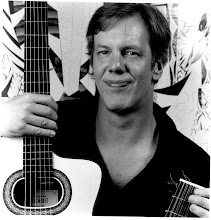It seems fair to share some of my playing, so here are some links to videos of my improvisation.
The first tune is "Avalon," a tune made famous by Al Jolson and included more recently on Herb Ellis and Duke Robillard's Conversations in Swing. The song was a top seller in 1920, and a virtual but inadvertent advertisement for the resort town on Catalina Island. Jolson was quick to understand that any song he touched would sell, and so he cut in on both composer credits and worse, composer royalties. The melody actually has its origin in Puccini;s aria "E Lucevan Le Stelle" from Tosca. The similarity was so strong that Puccini's publisher successfully sued Jolson's publisher in 1921 for $25,000 and all subsequent royalties. This version, like all the music that I will post, uses rhythm tracks that I made for use in dinner and cocktail gigs. As such, the audience is not really listening, at least from the start to the finish of a song, so the tracks are long!
The second is the song mentioned in the Barney Kessel lecture, "Cry Me a River." Kessel's arrangement and back-up to Julie London's incredible singing are the quintessential version, but some of the power of the original actually resides in the song.
The third is "Blues for Ophie," a progression I made up in a guitar lesson and then named after one of my cats. I had to name it something!
Here is a version of Dietz-Schwartz' "Alone Together." I first heard the song on Pat Martino's "Footprints" in the early 1970s and then stumbled across it anew while paging through the Fake Book. It was written in 1932 for the Broadway musical Flying Colors by Max Gordon and Howard Dietz, who also produced and directed the whow. The sheet music ranked as the top seller of the era.
No session is complete with a bossa nova, and one of the deservedly best-known is Kenny Dorham's "Blue Bossa." Dorham was a bebop trumpeter who played in the bands of Billy Esckstine, Dizzy Gillespie, Lionel Hampton and Mercer Ellington, and Charlie Parker. Although Dorham recorded with some of the most important musicians of his era and "Blue Bossa" is as well known as the bossa standards "Girl from Ipanema" and "Black Orpheus," this musician an his contributions have slipped virtually into obscurity.
"Black Orpheus" was composed by Luis Bonfa. Its name comes from a film retelling the Greek myth of Euridice and Orpheus from the black Brazilian point of view in a modern setting. The song has a second title, "A Day in the Life of a Fool."
Another ballad, "I'll Be Seeing You," by writen by Sammy Fain and Irving Kahal for the 1938 Broadway show Right This Way. Because it describes the longing for someone far away, it lived beyond its intended use in the musical and became immensely popular during World War II among lovers forced to separate.
"Out of Nowhere" was the collaborative effort of lyricist Edward Heyman ("Body and Soul," "When I Fall in Love") and musician and Johnny Green. Heyman and Green also co-authored "Body and Soul."
Green's earliest efforts were his most successful, and his best known hits, many of which have become standards, include "Out of Nowhere" (1931, included as a media file), "Rain, Rain, Go Away" (1932), "I Cover the Waterfront," "You're Mine, You," and "I Wanna Be Loved" (all 1933), and "Easy Come, Easy Go" (1934). All of these compositions were not aimed at the Swing market, which did not yet exist per se, but at the Sweet market for popular hits and dance band music.
Green entered Harvard at age 15, and shortly thereafter was essentially forced by his father into a career he did not want, that of a stockbroker. In his musical career, he worked early on as an arranger of dance band music for Guy Lombardo and later for Jean Goldkette. This author's great-aunt made Lombardo's tuxedo shirts, which included the underpants so that the shirt would not pull out when he lifted his arms to conduct!
"Out of Nowhere" decidedly shows the impact of the French Impressionist composers in its chromatic shift at the end of the first phrase and its shift back to the original tonic at the beginning of the second. The shift to ii7-V7 in a key one-step lower than the original anticipates the harmonic progressions of Charlie Parker and the bop generation by twenty years.
Tuesday, March 24, 2009
Subscribe to:
Post Comments (Atom)

No comments:
Post a Comment